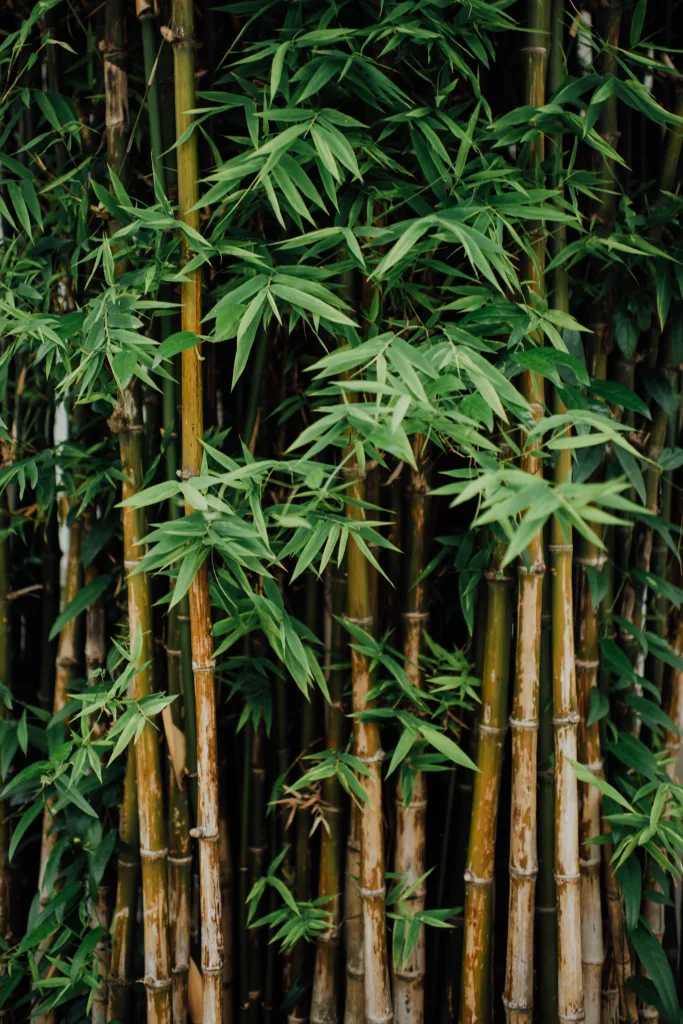No doubt you’ve all heard about the wonders of bamboo fabrics. They’ve been getting a lot of attention for being eco-friendly and sustainable. But, let’s get real for a moment—there’s more to the story than the marketing hype suggests. In this blog post, we’re going to have an honest chat about the pros and cons of bamboo fabric. We’ll explore its benefits, but we’ll also shine a light on some of its drawbacks. So, buckle up as we uncover the truth behind bamboo fabrics.
The Bamboo Plant: Best of the Best

Here’s one thing we can all agree on. Bamboo, a remarkable plant known for its versatility and sustainability, plays a significant role in promoting a greener environment. As one of the fastest-growing plants on Earth, bamboo exhibits an impressive lifecycle. It typically sprouts from rhizomes and can reach maturity within three to five years, unlike many trees that take decades. This rapid growth allows bamboo to regenerate quickly, making it an abundant and renewable resource. Additionally, bamboo requires minimal resources to thrive, including water, pesticides, and fertilizers. Its extensive root system helps prevent soil erosion and promotes stability in the surrounding ecosystem. Bamboo also has the remarkable ability to absorb large amounts of carbon dioxide and release oxygen, making it an excellent tool for combating climate change. This process, known as carbon sequestration, contributes to reducing greenhouse gas emissions and improving air quality. Furthermore, bamboo plantations act as natural habitats for various species, enhancing biodiversity. The versatility of bamboo extends to its various applications, from construction materials to textiles.
Antimicrobial and Hypoallergenic Properties: Good News for Sensitive Souls
You’ve probably heard that bamboo fabric offers some fantastic benefits, particularly when it comes to its natural antimicrobial properties. Let’s delve deeper into this.
Here’s what you’ll often hear:
Bamboo fabric contains a bio-agent called “bamboo kun,” which is naturally present in the plant. Bamboo kun is known to possess antimicrobial properties, meaning it has the ability to resist the growth of bacteria and fungi. This natural defense mechanism sets bamboo fabric apart from many other textile materials.
The antimicrobial nature of bamboo fabric provides several advantages. Firstly, it helps to inhibit the growth of odor-causing bacteria on the fabric. This means that even after extended wear or use, bamboo fabric tends to retain a fresher scent compared to other fabrics. So, if you find yourself struggling with unpleasant odors from your clothes or linens, bamboo fabric can be a game-changer.
Additionally, bamboo fabric’s antimicrobial properties can be beneficial for those with sensitive skin or allergies. Bacteria and fungi can sometimes trigger skin irritations, rashes, or allergic reactions. By resisting the growth of these microorganisms, bamboo fabric can help reduce the risk of such skin issues. This makes it an excellent choice for individuals with delicate or easily irritated skin.
BUT, we have to remain skeptical:
Bamboo kun is a substance that is naturally found in the bamboo plant itself, particularly in the green bamboo shoots. It acts as a natural defense mechanism for the bamboo plant against pests and pathogens. However, during the manufacturing process of bamboo fabric, the bamboo pulp undergoes significant chemical processing to extract and transform the cellulose into fibers. This process typically removes or significantly reduces the presence of bamboo kun and other natural components of the bamboo plant.
While bamboo kun is naturally found in the bamboo plant, its presence in the final bamboo fabric is a topic of debate. Some sources claim that a certain amount of bamboo kun may remain in the fabric after the manufacturing process, contributing to its antimicrobial properties. However, the extent to which bamboo kun persists in the fabric and its effectiveness as an antimicrobial agent are not well-established or widely agreed upon in scientific research.
It’s important to note that the manufacturing process of bamboo fabric, particularly the chemical treatments involved, can significantly alter the composition and properties of the original bamboo plant. So, claims regarding the antimicrobial properties of bamboo fabric should be approached with caution and may vary between different brands or products.
While bamboo fabric may still offer certain benefits and properties, such as softness, breathability, and moisture-wicking, it’s important to clarify that the antimicrobial properties of bamboo kun are not inherently present in the final bamboo fabric. The antimicrobial claims associated with bamboo fabric are often based on the presence of bamboo kun in the plant itself, rather than the fabric resulting from the manufacturing process.
To make an informed decision about bamboo fabric, it is advisable to consider other aspects such as the manufacturing process used, including any chemicals involved, as well as the overall sustainability and environmental impact of the specific product.
Softness and Breathability: A Luxurious Treat
Here’s another thing we can universally agree on with bamboo fabric: It has an fabulous feel. There’s a lot of marketing mumbo-jumbo out there that will go on and on about why it feels how it feels, but the fabric speaks for itself. Bamboo fabric is known for its heavenly touch—it’s as soft as silk or cashmere. Plus, it’s breathable, allowing for better airflow and keeping you cool and comfy. So, whether you live in a hot climate or tend to get a little toasty during sleep, bamboo fabric has got your back.
Durability: Not Its Strong Point
Alright, let’s be upfront about this one. Bamboo fabric’s durability can be a bit hit or miss. The viscose process used in its production can weaken the fibers, resulting in a fabric that might not hold up as well as you’d hope. In it’s 100% form, bamboo knit is known to lose its shape and not easily recover.
But not all hope is lost. Some manufacturers use different techniques to create stronger bamboo fabrics. Additionally, bamboo rarely used alone. It is typically blended with other fibers to balance out the weak points. Bamboo-cotton, for example are common with tshirts, where the well-known qualities of cotton lends strength to the blend. Also common is elastane (spandex), which helps the bamboo recover its shape.
Eco-Friendliness: It’s Complicated
Finally, let’s address the elephant in the room. Is bamboo fabric as eco-friendly as it’s made out to be? Well, that’s complicated. Yes, The bamboo plant itself is sustainable and has environmental benefits. But the manufacturing process, with its chemical use, takes away some of that eco-friendly shine. Let’s take a look at the manufacturing process itself:
Manufacturing Process: Where Things Get Tricky
Most bamboo fabrics you find on the market are made using a process called viscose or rayon. It’s not easy to turn a wood product into a fabric product. It’s a very different situation than something like cotton or wool that already has a physical structure that lends itself to making yarns. The intense process of manufacturing these bamboo fabrics typically involves harsh chemicals like sodium hydroxide and carbon disulfide. These chemicals are harmful to both our health and the environment. So, while bamboo fabric starts with good intentions, the manufacturing process makes it less natural or organic than it seems.
Read through the complete process of manufacturing bamboo:
- Bamboo Harvesting: The bamboo stalks are harvested when they reach maturity, usually around 3 to 5 years. The outer layers of the stalks are removed, leaving the inner core or culm.
- Extraction and Pulping: The bamboo culms undergo a treatment process to remove impurities and extract the cellulose fibers. This can be done through mechanical crushing or chemical processes like alkaline hydrolysis or enzyme treatment. The resulting pulp contains the bamboo fibers.
- Filtration and Drying: The bamboo pulp is filtered to remove any remaining impurities and then dried to reduce its moisture content.
- Chemical Treatment: To convert the bamboo pulp into a usable form for fabric production, it goes through a chemical process called viscose or rayon process. The pulp is dissolved in a chemical solvent, typically sodium hydroxide, to create a viscous solution.
- Extrusion and Regeneration: The viscous solution is extruded through spinnerets, which are fine nozzles, to form continuous filaments. These filaments are then immersed in a bath containing another chemical solution, such as sulfuric acid, to solidify and regenerate the cellulose fibers.
- Spinning and Yarn Formation: The regenerated bamboo fibers are spun into yarn through a spinning process. The yarn can be further processed to enhance its strength and uniformity.
- Weaving or Knitting: The bamboo yarn is woven on looms or knitted to create fabric. The weaving or knitting process determines the specific structure and texture of the fabric.
- Finishing: The bamboo fabric undergoes various finishing treatments to improve its properties and appearance. This may include processes like washing, bleaching, dyeing, printing, and applying softeners or finishes to enhance its softness, color, or performance.
As you can see, it’s COMPLICATED. But, it’s important to note that the exact manufacturing process can vary between different manufacturers and may involve alternative or modified methods to achieve specific fabric properties. Some manufacturers claim to have far more eco-friendly manufacturing methods, so if you’re using bamboo, be sure to do your research before settling on a particular one.
Is Bamboo a Natural Fabric?
The term “natural fabric” can be a bit ambiguous, but traditionally, viscose is not considered a natural fabric. Viscose is a type of rayon, and rayon is classified as a semi-synthetic fiber. While it is derived from natural materials, such as wood pulp (including bamboo pulp), the manufacturing process involves chemical treatments and processes that alter the natural state of the fiber.
Viscose production involves dissolving the cellulose from wood pulp or bamboo pulp into a solution, which is then regenerated into fibers through chemical processes. These processes typically use harsh chemicals like sodium hydroxide and carbon disulfide. Due to the significant chemical treatment involved, viscose is not considered as natural as materials like cotton, linen, or silk.
However, it’s worth noting that viscose from bamboo is often marketed as a more eco-friendly and sustainable alternative to conventional viscose, primarily due to the fast growth and renewable nature of bamboo plants. Nevertheless, from a technical standpoint, viscose is considered a semi-synthetic fiber rather than a natural fabric.
That’s a Wrap!
There you have it, folks—the honest scoop on bamboo fabrics! They’re not a flawless green dream, but they do offer certain advantages. Bamboo is a sustainable plant, and bamboo fabric possesses some desirable qualities like softness and breathability. Anti-microbial and all that… MAYBE. However, the manufacturing process raises concerns and impacts its overall eco-friendliness. So, when it comes to bamboo fabric, understanding the benefits and drawbacks will help you make an informed choice. Happy fabric shopping, and remember to stay skeptical!


